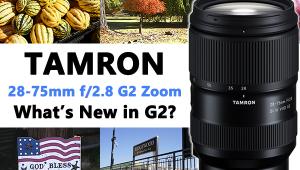Nikon’s AF-S DX Zoom-Nikkor 10-24mm f/3.5-4.5G ED Lens; Wide Angle When You Want It
The days when ultra-wide-angle lenses for APS-C (what Nikon calls DX format) digital cameras were rare or not very good are over. We have seen new options from independent and camera maker manufacturers alike, each bringing the fun and creative options of these unique angles of view to ever more affordable price ranges. The latest for Nikon in this genre is the Zoom-Nikkor 10-24mm lens ($900 MSRP), equivalent to (in 35mm format) a 15-36mm zoom for Nikon DX-format cameras given their 1.5x coverage magnification. Being a DX-type lens it can be used on Nikon’s (so-called full frame) FX cameras in DX Crop mode, yielding the earlier-mentioned range.
 |
Like many in this relatively affordable category, the lens is variable aperture, with maximum apertures being f/3.5 at 10mm, f/3.8 at 12mm, f/4 at 15mm, and f/4.5 at 20mm and above settings. While not fast overall (having grown up with 24mm f/2 and 20mm f/2.8 manual focus Nikkors), this seems somewhat less of a problem in the variable ISO digital world, and the less than one-stop loss from the shortest to the longest focal-length range is not so bad for variable-aperture zooms.
The lens has some very nice Nikon tech touches, including two ED glass elements and three aspherical elements, plus Nikon’s special coating to reduce flare, though using the included petal-shaped lens hood on a wide such as this is always a good idea. The aspherical elements and ED glass contribute to very good performance chromatic aberration-wise, which I verified through my field test of tree branches against a deep blue sky, magnified many times. The Nikon Silent Wave Motor makes AF, well, silent and fast. The diaphragm is composed of seven blades, which bokeh fans will like for background highlights, and to get those really soft backgrounds they will also appreciate the fact that you can focus as close as about 10” at all focal lengths, which will help get shallow depth of field in a lens as wide as this, as well as amazing deep depth of field potential.
|
Zoom Potential
|
|
 |
|
 |
|
|
The lens is not heavy, at 16.2 oz, or bulky, at 3.25x3.43”, but the front element is, as expected, fairly large, at 77mm, so any polarizing, ND, or grad filters could get expensive. When zooming the lens travels ever so slightly (this is an internal focus lens, thus no problem with polarizing filters) but not more than 1⁄4” or so by my measurements. When the lens hood is mounted add about 2” to the overall length.
For those who have not shot with a super-wide the 10mm focal-length setting can be quite a revelation, though it will at that focal length distort subjects at the edges of the frame. The big fun of this wide a lens is how objects photographed close become foreshortened (exaggerated sense of size) in comparison to the rest of the subjects. Think of looking at your watch close-up and seeing the rest of the world in sharp focus at the same time. Combine this with an f/22 aperture setting and proper placement of the point of focus to maximize depth of field and you get into some interesting points of view.
|
Wide View
|
|
 |
|
|
The fact that you can zoom out to a more “normal” point of view at the 36mm setting makes this a more useful lens than if it were just a fixed focal-length 10mm, at least in my opinion. The seduction of super-wide can be a passing fancy, where the image effect eventually might overwhelm the image itself—it can be too much of a very good thing. Using this lens on a video-capable D-SLR, however, might yield some interesting effects, to say the least.
The close-focusing ability of the lens also enhances its usefulness, and is something I think nature photographers will appreciate. Being able to get close in and work with a narrow aperture, given the right relationship of near to far subjects, can be quite startling. The wide point of view combined with the deep depth of field even at middling apertures will also be appreciated by street photographers, who can literally set the lens at f/11 (or narrower if the light is right) and shoot away without having to worry about focusing the shot. While the fairly slow performance at 24mm (f/4.5 maximum) does limit its total usefulness as a street lens, one can raise ISO to reasonable limits these days (ISO 400 is no problem, and ISO 800 is becoming less so) to compensate.
|
Near And Far
|
|
 |
|
|
I made most of my test shots with a Nikon D300—in the field on hikes and various excursions around Taos, New Mexico. I also checked out vignetting by using a sunlit wall and shot at wide-open, a middle aperture, and at the narrowest aperture at the 10mm, 12mm, 18mm, and 24mm focal-length settings and found none discernible to the eye.
After working with the lens for about a week I came to find it a most excellent companion for nature work and landscape photography, though I’m sure if I had worked with it in my usual haunts on the streets of New York City it would have been just as fun. Having always been a fan of wide-angle lenses and short-ratio zooms, I can say that this is one lens that would always find a welcome home in my camera bag.
For more information, contact Nikon Inc. at: www.nikonusa.com.
- Log in or register to post comments

















































